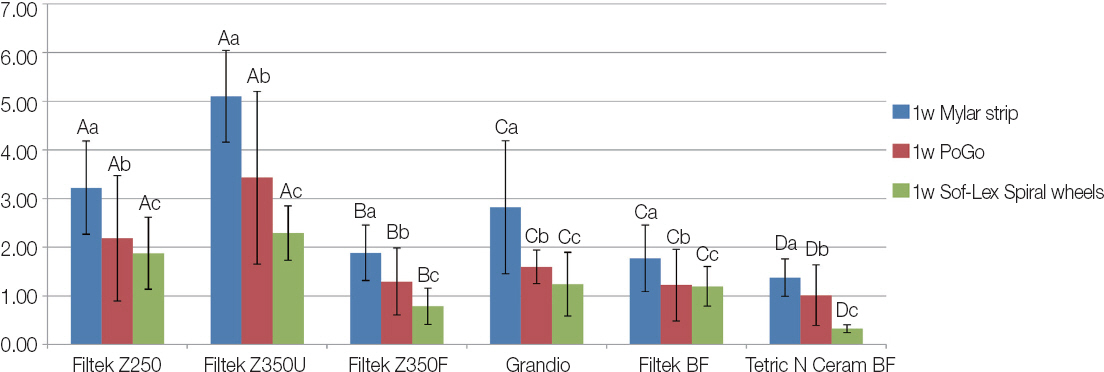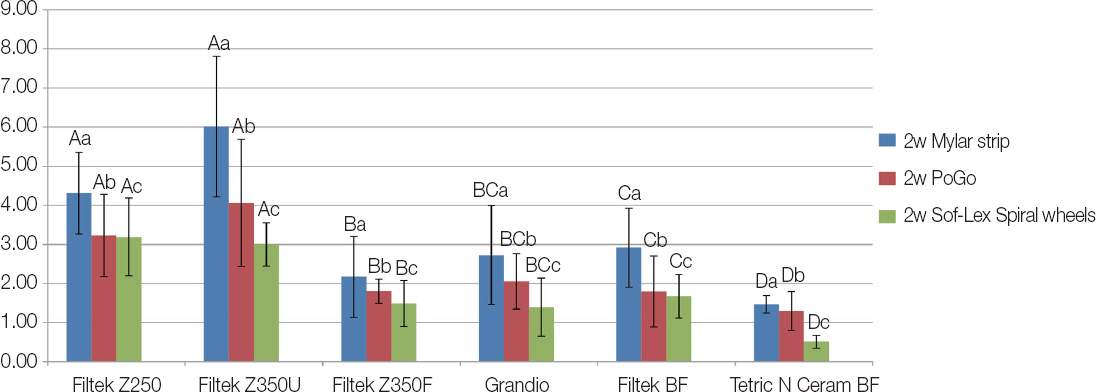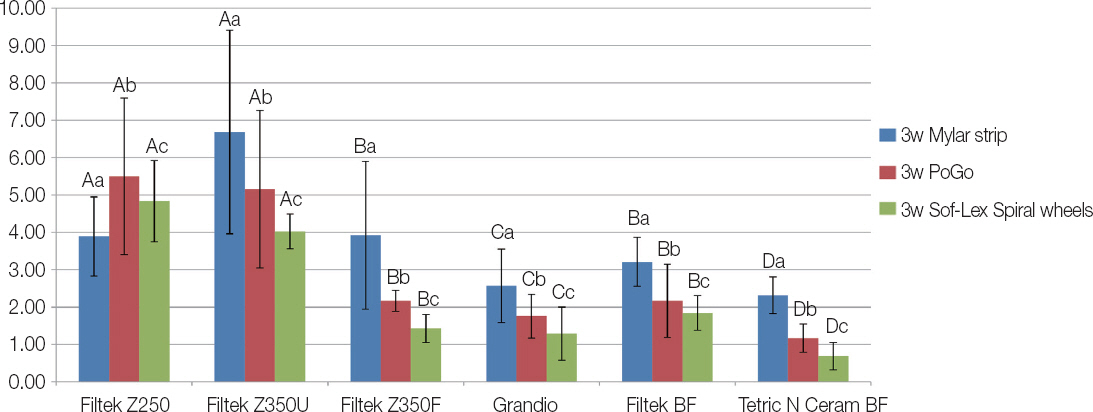J Dent Rehabil Appl Sci.
2019 Mar;35(1):1-10. 10.14368/jdras.2019.35.1.1.
Effect of polishing methods on color change by water absorption in several composite resins
- Affiliations
-
- 1Department of Conservative Dentistry, Veterans Health Service Medical Center, Seoul, Republic of Korea. endo95@naver.com
- KMID: 2450920
- DOI: http://doi.org/10.14368/jdras.2019.35.1.1
Abstract
- PURPOSE
The aim of this study was to evaluate the influence of polishing methods on the color stability of composite resins.
MATERIALS AND METHODS
Two bulk-fill and four conventional resin composites were filled in cylindrical molds (6 mm diameter, 4 mm height) and light-cured. The specimens were stored in 34℃ distilled water for 24 h. Spectrophotometer was used to determine the color value according to the CIE L(*)a(*)b(*) color space. Each group was divided into three groups according to polishing methods (n = 5). Group 1 was control group (Mylar strip group), group 2 was polished with PoGo, and group 3 was polished with Sof-Lex Spiral wheels. Color evaluation was performed weekly for 4 weeks after immersion in 34℃ distilled water. The results were analyzed by generalized least squares method (P < 0.05).
RESULTS
Generalized least squares analysis revealed that Sof-Lex Spiral wheels group showed the significantly lower ΔE values compared to PoGo and control group (P < 0.05). The ΔE values of polished group showed the significantly lower than the ΔE values of unpolished group (P < 0.05). Regarding color changes of composite resins, there was no significant difference between the ΔE values of Filtek Z250 and Filtek Z350 XT Universal restorative in all time intervals (P < 0.05). Tetric N-Ceram Bulk Fill showed the significantly lower ΔE values compared to other composite resins in 1, 2, 3 weeks (P < 0.05).
CONCLUSION
Within the limitations of this study, polishing methods influence the color stabilities of composite resins. The group polished with Sof-Lex Spiral Wheels showed more resistance to discoloration than group polished with PoGo.
Keyword
MeSH Terms
Figure
Reference
-
References
1. Schmitt VL, Puppin-Rontani RM, Naufel FS, Nahsan FP, Alexandre Coelho Sinhoreti M, Baseggio W. Effect of the polishing procedures on color stability and surface roughness of composite resins. ISRN Dent. 2011; 2011:617672. DOI: 10.5402/2011/617672. PMID: 21991483. PMCID: PMC3169916.2. Douglas WH, Craig RG. Resistance to extrinsic stains by hydrophobic composite resin systems. J Dent Res. 1982; 61:41–3. DOI: 10.1177/00220345820610010901. PMID: 6459347.3. Shamszadeh S, Sheikh-Al-Eslamian SM, Hasani E, Abrandabadi AN, Panahandeh N. Color Stability of the Bulk-Fill Composite Resins with Different Thickness in Response to Coffee/Water Immersion. Int J Dent. 2016; 2016:7186140. DOI: 10.1155/2016/7186140. PMID: 27403163. PMCID: PMC4923579.4. Rueggeberg FA, Margeson DH. The effect of oxygen inhibition on an unfilled/filled composite system. J Dent Res. 1990; 69:1652–8. DOI: 10.1177/00220345900690100501. PMID: 2212209.5. Attar N. The effect of finishing and polishing procedures on the surface roughness of composite resin materials. J Contemp Dent Pract. 2007; 8:27–35. PMID: 17211502.6. Patel B, Chhabra N, Jain D. Effect of different polishing systems on the surface roughness of nanohybrid composites. J Conserv Dent. 2016; 19:37–40. DOI: 10.4103/0972-0707.173192. PMID: 26957791. PMCID: PMC4760010.7. Kritzinger D, Brandt PD, De Wet FA. The effect of different polishing systems on the surface roughness of a nanocomposite and a microhybrid composite. SADJ. 2017; 72:249–57. DOI: 10.17159/2519-0105/2017/v72no6a1.8. Munteanu B, Andrian S, Ursu L, Stoleriu S, Iovan G, Ghiorghe CA. Evaluation of surface condition after finishing and polishing of a flowable composite material. Int J Med Dent. 2016; 6:124–9.9. Ilie N, Bucuta S, Draenert M. Bulk-fill resin-based composites:an in vitro assessment of their mechanical performance. Oper Dent. 2013; 38:618–25. DOI: 10.2341/12-395-L. PMID: 23570302.10. Bucuta S, Ilie N. Light transmittance and micromechanical properties of bulk fill vs. conventional resin based composites. Clin Oral Investig. 2014; 18:1991–2000. DOI: 10.1007/s00784-013-1177-y. PMID: 24414570.11. Liberman R, Combe EC, Piddock V, Pawson C, Watts DC. Development and assessment of an objective method of colour change measurement for acrylic denture base resins. J Oral Rehabil. 1995; 22:445–9. DOI: 10.1111/j.1365-2842.1995.tb00799.x. PMID: 7636615.12. Ergücü Z, Türkün L, Aladag A. Color stability of nanocomposites polished with one-step systems. Oper Dent. 2008; 33:413–20. DOI: 10.2341/07-107. PMID: 18666499.13. Türkün LS, Türkün M. The effect of one-step polishing system on the surface roughness of three esthetic resin composite materials. Oper Dent. 2004; 29:203–11. PMID: 15088733.14. Lu H, Roeder LB, Powers JM. Effect of polishing systems on the surface roughness of microhybrid composites. J Esthet Restor Dent. 2003; 15:297–304. DOI: 10.1111/j.1708-8240.2003.tb00300.x. PMID: 14620660.15. Venturini D, Cenci MS, Demarco FF, Camacho GB, Powers JM. Effect of polishing techniques and time on surface roughness, hardness and microleakage of resin composite restorations. Oper Dent. 2006; 31:11–7. DOI: 10.2341/04-155. PMID: 16536188.16. Sideridou I, Tserki V, Papanastasiou G. Study of water sorption, solubility and modulus of elasticity of light-cured dimethacrylate-based dental resins. Biomaterials. 2003; 24:655–65. DOI: 10.1016/S0142-9612(02)00380-0.17. Choi MS, Lee YK, Lim BS, Rhee SH, Yang HC. Changes in surface characteristics of dental resin composites after polishing. J Mater Sci Mater Med. 2005; 16:347–53. DOI: 10.1007/s10856-005-0634-9. PMID: 15803280.18. Villalta P, Lu H, Okte Z, Garcia-Godoy F, Powers JM. Effects of staining and bleaching on color change of dental composite resins. J Prosthet Dent. 2006; 95:137–42. DOI: 10.1016/j.prosdent.2005.11.019. PMID: 16473088.19. Ertaş E, Güler AU, Yücel AC, Köprülü H, Güler E. Color stability of resin composites after immersion in different drinks. Dent Mater J. 2006; 25:371–6. DOI: 10.4012/dmj.25.371. PMID: 16916243.20. Thumu J, Kadiyala A, Bollu IP, Ballullaya SV, Devalla S. Effect of Staining Solutions on the Color Stability of Conventional and Bulk Fill Nanohybrid Resin Composites:A Spectrophotometric Analysis. J Oper Dent Endod. 2017; 2:1–5. DOI: 10.5005/jp-journals-10047-0024.21. Buchalla W, Attin T, Hilgers RD, Hellwig E. The effect of water storage and light exposure on the color and translucency of a hybrid and a microfilled composite. J Prosthet Dent. 2002; 87:264–70. DOI: 10.1067/mpr.2002.121743. PMID: 11941352.22. Johnston WM, Kao EC. Assessment of appearance match by visual observation and clinical colorimetry. J Dent Res. 1989; 68:819–22. DOI: 10.1177/00220345890680051301. PMID: 2715476.23. Inokoshi S, Burrow MF, Kataumi M, Yamada T, Takatsu T. Opacity and color changes of tooth-colored restorative materials. Oper Dent. 1996; 21:73–80. PMID: 8957922.24. Moore RJ, Watts JT, Hood JA, Burritt DJ. Intra-oral temperature variation over 24 hours. Eur J Orthod. 1999; 21:249–61. DOI: 10.1093/ejo/21.3.249. PMID: 10407534.
- Full Text Links
- Actions
-
Cited
- CITED
-
- Close
- Share
- Similar articles
-
- Understanding of the color in composite resin
- Surface roughness and color stability of various composite resins
- Color Stability and Surface Roughness of Single-Shade Composite Resin after Finishing and Polishing
- Effect of immersion into solutions at various pH on the color stability of composite resins with different shades
- Color changes in composite resins exposed to xenon lamp





